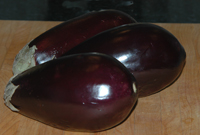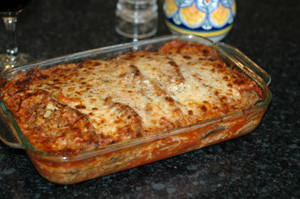 How is it that the eggplant, a vegetable grown since before recorded history and consumed today around the clock like pasta and pizza, still fires up controversy? You’d think we all would be on the same page by now. Or maybe I’m the only one off the page with the rest of the world. I’ll explain.
How is it that the eggplant, a vegetable grown since before recorded history and consumed today around the clock like pasta and pizza, still fires up controversy? You’d think we all would be on the same page by now. Or maybe I’m the only one off the page with the rest of the world. I’ll explain.
It’s time to nerdle over two questions that come up from time to time. Number one, should you peel the eggplant before cooking, and two, should you salt the slices and lay them in a colander under a large can of tomatoes sitting on a dinner plate to get rid of the alleged noxious bitter flavor from the ugly brown juices?
As to the first question my answer is the typical legal sidestep: It depends on how you want the presentation to look. Some eggplant dishes need the skin to provide color contrast, some don’t. I happen to be an enthusiastic peeler.
As to the second my answer is a resounding never!
To defend these viewpoints I first enlisted the help of the International Society for the Advancement of Eggplant Cuisine based in Tangier, Morocco. Turns out they never considered the questions and weren’t interested. So much for those people. Thus I turned to the usual suspect sources, i.e. the internet and in particular Wikipedia, not to exclude my standby web-based experts from Italy.
First as to peeling off the skin my reason for doing so is that in many cases the cooked skin tends to separate from the flesh by itself as you consume the course, leaving an unsightly tangle of loose black skin, edible as it may be, hanging around in the dish waiting for you to suck it up. No thanks. Try ordering Pasta alla Norma sometime and watch what happens when you start poking at the unskinned eggplant chunks.
To execute the peeling process I use a standard dollar eighty-eight vegetable peeler. Takes a little practice. It’s better than hacking away at the eggplant with a 10-inch chef knife, which takes out half the pulp along the way. I watched Rachel Ray do this once. I wanted to cry. Actually I did cry – briefly.
Second as to salting and draining, it seems that cultivation and cross breeding over the centuries has had the effect of reducing the bitterness of the seeds and ugly brown juice surrounding them. Leaving out the step saves more than an hour of prep time for my eggplant parmesan, which is a time consuming enough of a dish as it is.
All that said I also discovered through my usual thorough research that the foregoing opinions are at variance with just about everybody in the cooking world, even the Sicilians, who claim eggplant as their national vegetable.
I was particularly devastated to watch a video on an Italian website that I consider reliable, wherein Sonia, the nice young lady chef coolly sliced up the unpeeled eggplant lengthwise and then proceeded with the tedious dehydration process, with heavy can of tomatoes sitting on top of the serving plate, sitting on top of the eggplant, sitting in the colander, sitting on a plate to catch the liquid. You know the drill.
If I’m not mistaken Mario Batali may be the only chef around who agrees with me about skipping the salt ritual. Or is it vice versa?
 Now the challenge. I propose to make eggplant parmesan with the same recipe except for one variation, one with the salting business and one without. I then propose to seat my committee of Sicilians at the table and defy them to identify which version was salted and drained and which was not. One Thousand Euro to the team if they get it right. Any Sicilians in the audience wanna step up?
Now the challenge. I propose to make eggplant parmesan with the same recipe except for one variation, one with the salting business and one without. I then propose to seat my committee of Sicilians at the table and defy them to identify which version was salted and drained and which was not. One Thousand Euro to the team if they get it right. Any Sicilians in the audience wanna step up?
All of which mercifully brings us to the actual recipe, knowing full well that there are as many variations as stars in the sky. But my theory is that somewhere in the dim past an unknown chef stumbled onto what eventually became accepted as the “original.” As usual I entered the Italian sites and looked around for a recipe version that more or less incorporates as many consensus features as possible, yielding as close to the elusive original as one can create.
To make it interesting I set up a comparison sheet showing my preferred style compared with two others, one from my reconstruction of typical Italian recipes from the web and another from Chef Alex Guarnischelli whose variation can be found on the Food Network site.
Melanzana alla Parmigiana – Three Ways
| Chef L | Italy | Chef Guarnischelli |
| 2 large or 3 medium eggplants skin removed | 2 large or 3 medium eggplants | 2 medium eggplants |
| 1 cup all purpose flour for dredging | no flour | 1/2 cup all purpose flour |
| fine salt, preferably popcorn salt | table salt | table salt |
| freshly ground black pepper | no pepper | freshly ground black pepper |
| no eggs | no eggs | five large eggs |
| no milk | no milk | 3 tbsp. whole milk |
| no breadcrumbs | no breadcrumbs | 4 cups breadcrumbs |
| dried thyme, dried oregano, fresh basil | fresh basil only | dried thyme, dried oregano, fresh basil |
| mozzarella cheese | no mozzarella | mozzarella cheese |
| parmesan cheese | parmesan cheese | parmesan cheese |
| no provolone | caciocavallo or “provola” | 1 lb. provolone cheese grated |
| tomato sauce NO SUGAR | tomato sauce NO SUGAR | tomato sauce w/sugar added |
So here are the differences:
First, the recipe with the fewest ingredients is the Italian. This contrasts with the Italian-American chefs tendency to load up a recipe – any recipe for that matter. It’s like the more ingredients the better it must be. Certainly that is my tendency unfortunately, and apparently the same for Alex Guarnischelli. At least I ditch the eggs and breadcrumbs.
Second all three sauces are no doubt different BUT NOTE — the Guarnischelli recipe adds sugar to the tomato sauce, a practice which I condemn as grounds for excommunication! In Ms. Alex’s defense I am well aware that hundreds of professional and home chefs in Italy do the same, which does not excuse the offense. You don’t need the extra carbs.
Lastly, all three recipes ultimately call for lightly frying the eggplant slices, whether dredged in only flour, flour, egg, milk and crumbs, or plain naked, draining on paper towels and then alternately layering the sauce, cheese and eggplant in a baking dish in the typical fashion. Baking temp is around 375 degrees for 30 minutes or so.
It’s all a matter of taste to repeat the cliche’ but nonetheless if you’re a cardiologist you will quickly choose either my version or the one from Italy and skip Alex’s. In any case please also skip the salting ritual. If you can’t, I suggest counseling.
